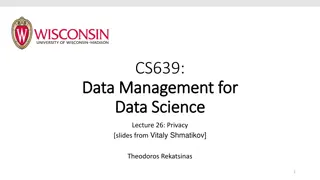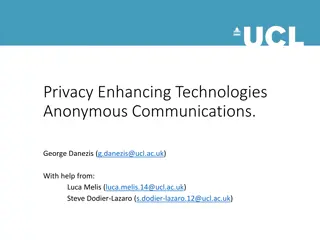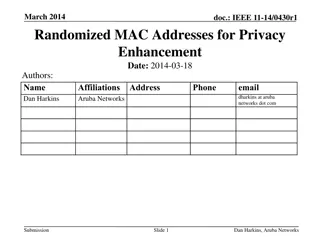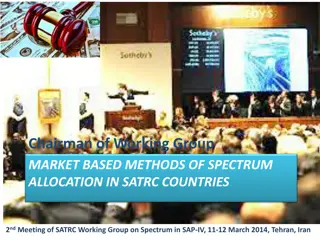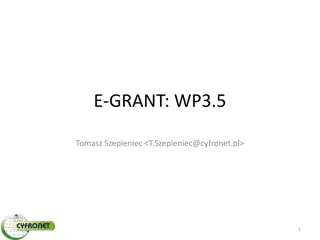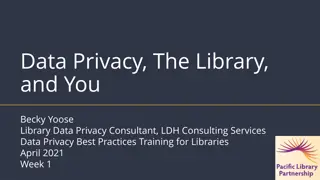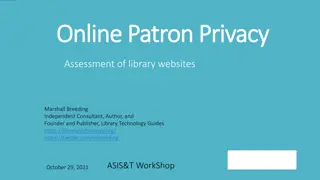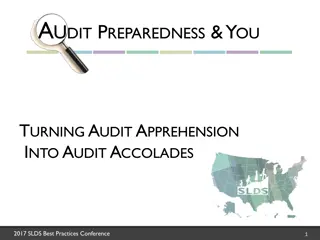Enhancing Privacy in Crowdsourced Spectrum Allocation
This research focuses on protecting privacy in crowdsourced spectrum allocation, addressing the security challenges faced due to the presence of multiple entities and the sensitive information collected. By proposing potential ideas like Fully Homomorphic Encryption (FHE) and Secure Multi-Party Computation (MPC), the aim is to secure the allocation process without compromising efficiency. Traditional models, attenuation factors, and the crowdsourced sensing model are discussed, highlighting the need for secure solutions in utilizing shared spectrum efficiently.
- Privacy protection
- Crowdsourced spectrum allocation
- Security challenges
- Fully Homomorphic Encryption
- Secure solutions
Download Presentation

Please find below an Image/Link to download the presentation.
The content on the website is provided AS IS for your information and personal use only. It may not be sold, licensed, or shared on other websites without obtaining consent from the author. Download presentation by click this link. If you encounter any issues during the download, it is possible that the publisher has removed the file from their server.
E N D
Presentation Transcript
ProCSA: Protecting Privacy in Crowdsourced Spectrum Allocation Max Curran, Xiao Liang, Himanshu Gupta, Omkant Pandey, Samir Das
Background and Motivation Radio Frequency is a limited resource. More and more demand recent years (e.g. mobile devices). A Solution: Shared Spectrum Paradigm - - - There might be unused spectrum bands (primary user absent). Allow secondary user to use these bands. Implemented with Crowdsourced Sensing Model
Traditional model Attenuation between sender and receiver Path-loss function: how attenuation is affected by different types of factors (e.g. distance, geographic condition, temperature, weather ) Traditional model: measure those factors and then use a propagation model to compute the path-loss function Tow propagation models: Log distance, Longly-Rice Primary User (PU) Primary User s reciever (PUR)
Crowdsourced Sensing Model Primary User s reciever (PUR) Primary User (PU) Sensor (SS) SU SM
Security Challenges Crowdsourced sensing is faced with serious security challenges due to: The presence of many independent entities (PU/PUR/SS/SU) Spectrum Manager (SM) collects sensitive information: locations, transmit power, sensing reports, requested spectrum, etc. The goal of our work: Make the allocation procedure as secure as possible Without sacrificing efficiency too much
Potential Ideas Fully Homomorphic Encryption (FHE) Introduce a key sever Let SM do the computation on encrypted data Secure Multi-Party Computation (MPC) Introduce more SM instances Distribute the computation among them No proper subsets of SMs can collude to learn confidential info
FHE-Based Solution? FHE is very powerful However, far from being practical Relax the requirement: Linear homomorphism. E.g. ? ? = ? + ? ? Paillier s crytosystem achieves this [Pai99] P2-SAS: state-of-the-art approach [DZL+17] Traditional model: assume a propagation model, prefix the path-loss function. express the core part of allocation algorithm as a linear function. Use Paillier. provide Yes/No answers.
MPC-Based Solution Also not practical. Fast implementation for 2PC/3PC in the semi-honest model. As we will show in our work, this approach enjoys the following advantages: Capture general spectrum allocation algorithm (not limited to linear functions). Use up-to-date parameters, do the allocation dynamically. Output directly the allocated spectrum value (not Yes/No) More efficient.
Outline In the remaining part of this talk: Our plain algorithm (i.e. without security concerns) How to make it secure using 2PC Empirical results
A Dynamic Spectrum Allocation Primary User s Recievor (PUR) Primary User (PU) Sensor (SS) (3) update SU (1) path-loss estimation (2) allocation SM
A Dynamic Spectrum Allocation (1) Compute path-loss function between SU ??and PUR ??: ? ??,?? (2) Compute the allocated value ??as: ?? , ?? ???? ? ??, ?? ??is the threshold of each PUR (3) Update the threshold of each PUR: ?? ?? ? ??,?? ??
1. 2. 3. Path-loss estimation Compute the allocated value Threshold updating Grid-Based Optimization
Are We Done? Our plain algorithm seems efficient (only involves the most related nodes) 2PC is efficient. So use a fast 2PC library to implement our plain algorithm. Wait ... 2PC is only practical if the circuit description of the algorithm is not huge. Our algorithm maintains an array. Using Circuits to describe arrays would be prohibitively inefficient.
MPC for Oblivious RAM RAM-MPC e.g. Gorden et al. [GKK+12]: A framework that conbines any 2PC and ORAM. Implementation Issues: There exist different packages maintained by different teams/researchers incompatible with each other Our algorithm switches between Boolean/Arithmetic operations We design a new oblivious read/write method Simple (no need to deal with eviction or storage structure etc.) Perfect correctness Works well with our algorithm
Oblivious Read: A toy example [2] [1] [3] Addition (Mod 5) 0 0 1 0 1 1 0 0 1 0 1 0 1 1 1 Output: Both parties learn a secret-share of 1
[2] [1] [3] 0 0 1 0 1 1 0 0 1 0 1 0 1 1 1 Rotate by 3 Rotate by 1 1 0 1 0 0 0 1 0 0 1 [2], 3 [1], 1 2PC [4] [1] Mask by 11011 Mask by 10100 Oblivious Transfer 0 1 1 1 1 1 0 1 0 1 2PC 1 1 1 0 1 = (1 - 0) + (1 - 1) 1 0 re-share: 1 = 1 + 0
Oblivious Write The technique is different from our Oblivious Read But it is of the same flavor See our paper for details
Empirical Results Main factors affecting the performance: Number of selected nodes (SSs and PUs) in the interpolation step Size of the grid Settings of our simulation: A geographic area of 10km 10km; 400 PUs and 40000 SSs, randomly distributed; 5 PURs for each PU, located at 100m around the PU; Ground Truth Generator: log-distance (Log) and Longley-Rice (L-R)
Empirical Performance and Comparison Time Error Rate Comm. Cost P2-SAS 7 seconds 2.72% 5 MB ProCSA 2 seconds 1 dB (Log Distance) 4 dB (Longley-Rice) 0.15 MB
Conclusion and Future work Summary: A new method to conduct fast Spectrum Allocation. Crowdsourced sensing model, up-to-date data Make it secure using a special purpose 2PC. Without sacrificing efficiency too much. Potential Directions: Improve the efficiency and accuracy further. Secure in the malicious model.
Thank you! Q & A
Path-Loss Estimation Final goal: path-loss between ??and all PUR ??: ? ??,?? Notation: Use ?? ?to denote the PUR of PU ??. Estimation Procedure: Use interpolation to estimate the path loss between ??and ??. Known distance from ??to ?? There is a way to compute the final target ? ??,?? from the above two values ?. Highlight: the effective coverage of Si s signal is limited Optimization: Grid the area Just do all the above in the area that contains S.
PUs coverage region (1a) Split the sensed aggregate power x x PURs PU x PU x (2) Compute SU- PUR path loss PU x x SS PU SS (1b) Estimate PU-SU path-loss from PU-SS s by interpolation SS SU















